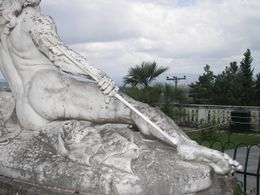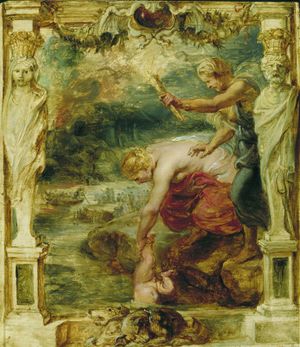“阿喀琉斯之踵”的版本间的差异
| 第1行: | 第1行: | ||
| − | + | {{#seo: | |
| − | + | |keywords=致命弱点,希腊神话,特洛伊战争 | |
| − | + | |description=致命弱点,希腊神话,特洛伊战争 | |
| + | }} | ||
{{short description|Critical weakness which can lead to downfall in spite of overall strength}} | {{short description|Critical weakness which can lead to downfall in spite of overall strength}} | ||
| − | {{ | + | [[File:Detail_of_Achilles_thniskon.jpg|thumb|260px|希腊科孚岛“垂死的阿喀琉斯”雕像]] |
| + | '''阿喀琉斯之踵 Achilles' heel'''<ref>{{Cite web|url=https://dictionary.cambridge.org/dictionary/english/achilles-heel|title=Achilles heel {{!}} meaning in the Cambridge English Dictionary|website=dictionary.cambridge.org|language=en|access-date=2019-09-29}}</ref><ref>{{Cite web|url=https://www.lexico.com/en/definition/achilles_heel|title=Achilles heel {{!}} Definition of Achilles heel by Lexico|website=Lexico Dictionaries {{!}} English|language=en|access-date=2019-09-29}}</ref>是指强大整体致命的弱点。虽然“阿喀琉斯之踵”一词的神话起源指的是身体的脆弱性,但在习惯表达中也常用于其他能摧毁整体的特征或属性。 | ||
| − | |||
| − | |||
== 起源 == | == 起源 == | ||
| 第13行: | 第13行: | ||
| − | [[File: | + | [[File:Peter_Paul_Rubens_181.jpg|thumb|right|由彼得·保罗·鲁本斯 Peter Paul Rubens创作的油画(约1625年),女神Thetis在流经地狱的冥河中浸泡她的儿子Thetis。背景中,摆渡人卡戎 Charon撑着船运为死者摆渡。]] |
| 第19行: | 第19行: | ||
| − | + | 古典神话中将Achilles的坚不可摧归功于他的母亲Thetis,Thetis曾经给他吃过珍馐(专供给神的食物),并提着Achilles的脚后跟在天炉里煅烧。他的父亲珀琉斯 Peleus发现Thetis使用这种治疗方法后非常担忧,这不仅激怒了Thetis,也使她未能完成治疗。<ref>Apollonius, Argonautica 4.869–872</ref> 而根据后来出现的另一个神话,Achilles的母亲抓住他的脚后跟,将他在冥河水里蘸了一下,他与河水接触到的地方变得坚不可摧——除了脚后跟被他母亲的拇指和食指捏住的地方。<ref>Statius, Achilleid 1.122f., 269f., 480f.</ref> | |
| − | |||
| − | |||
| − | |||
| − | |||
| − | |||
| − | |||
| − | |||
| − | |||
| − | |||
| − | |||
| − | |||
| − | |||
| − | |||
| − | |||
| − | |||
| − | |||
| − | |||
| − | |||
| − | |||
| − | |||
| − | |||
| − | |||
| − | |||
| − | |||
| + | 已知最初的关于Achilles的文字记录是由佛兰德/荷兰解剖学家菲利普·费尔海因 Philip Verheyen在1693年撰写的。在他的著作《人体解剖学 Corporis Humani Anatomia》中,他描述了跟腱的位置,并说它通常被称为“阿喀琉斯之踵”。<ref>}}|title=Corporis humani anatomia|last1=Veheyen|first1=Philip|authorlink=Philip Verheyen|publisher=Aegidium Denique|place=Leuven|year=1693|quote=Vocatum passim ''chorda Achillis'', & ab Hippocrate ''tendo magnus''. (Appendix, caput XII. ''De musculis pedii et antipedii'', p. 269)|url=https://archive.org/stream/corporishumanian00verh#page/268/mode/2up|accessdate=12 Mar 2018|page=269</ref><ref name="Klenerman2007">{{cite journal |last1=Klenerman |first1=L. |title=The early history of tendo Achillis and its rupture |journal=The Journal of Bone and Joint Surgery. British Volume |date=April 2007 |volume=89-B |issue=4 |pages=545–547 |doi=10.1302/0301-620X.89B4.18978|pmid=17463129 }}</ref>用“阿喀琉斯之踵”表达“弱点所在,脆弱的地方”,最早只能追溯到1840年,同时1810年《牛津英语词典》中,塞缪尔·泰勒·柯勒律治 Samuel Taylor Coleridge隐晦地使用过“爱尔兰,那英国的阿喀琉斯脆弱的脚后跟!Ireland, that vulnerable heel of the British Achilles!”这一表达。<ref>{{Cite web| url=https://www.oed.com/start;jsessionid=7F12E25F0F46A5BB16B0EAE3979CBEB6?authRejection=true&url=%2Fview%2FEntry%2F272524%3FredirectedFrom%3DAchilles%2520heel| title=Home : Oxford English Dictionary|website=www.oed.com|language=en|access-date=2019-09-29}}</ref> | ||
==解剖学 Anatomy== | ==解剖学 Anatomy== | ||
| − | |||
| − | |||
腓肠肌、比目鱼肌和跖肌的大而突出的肌腱称为小腿腱或跟腱。这个部位通常与阿喀琉斯的致命伤的部位有关。肌腱是无血管的,所以这种损伤不太可能是致命的; 然而,神话中的箭淬上了勒拿九头蛇有毒的血液。 | 腓肠肌、比目鱼肌和跖肌的大而突出的肌腱称为小腿腱或跟腱。这个部位通常与阿喀琉斯的致命伤的部位有关。肌腱是无血管的,所以这种损伤不太可能是致命的; 然而,神话中的箭淬上了勒拿九头蛇有毒的血液。 | ||
| 第58行: | 第33行: | ||
==参见== | ==参见== | ||
| − | |||
| − | |||
*{{wiktionary|Achilles heel}} | *{{wiktionary|Achilles heel}} | ||
| 第78行: | 第51行: | ||
[[Category: 阿喀琉斯]] | [[Category: 阿喀琉斯]] | ||
| + | ---- | ||
| + | 本中文词条[[用户:Agnes|Agnes]]翻译,由[[用户:Miyasaki|Miyasaki]]审校,张江总审校,[[用户:薄荷|薄荷]]编辑欢迎在讨论页面留言。 | ||
| − | + | '''本词条内容翻译自 wikipedia.org,遵守 CC3.0协议。''' | |
| − | |||
| − | |||
2020年11月14日 (六) 23:24的版本
阿喀琉斯之踵 Achilles' heel[1][2]是指强大整体致命的弱点。虽然“阿喀琉斯之踵”一词的神话起源指的是身体的脆弱性,但在习惯表达中也常用于其他能摧毁整体的特征或属性。
起源
在希腊神话中,当阿喀琉斯 Achilles还是个婴儿的时候,人们就预言他会英年早逝。为了阻止Achilles的死亡,他的母亲忒提丝 Thetis把他带到冥河,并把他的身体浸入河水中,因为冥河水据说可以提供刀枪不入的能力;然而,由于Thetis提着Achilles的脚后跟,所以他的脚后跟并没有被浸泡到冥河的水里。Achilles长大后成为一个战士,在许多伟大的战役中幸存下来。
尽管赫克托 Hector在荷马史诗《伊利亚特 Iliad》中预言了Achilles的死亡,但Achilles之死实际上并没有出现在《伊利亚特》中,而是出现在后来的古希腊罗马诗歌和戏剧[3]所描述的《伊利亚特》之后的事件中,后来又出现在特洛伊战争中。在围绕特洛伊战争的神话中,据说Achilles是死于脚跟[4][5] 、脚踝[6]或躯干的伤口[4] 。[7]
古典神话中将Achilles的坚不可摧归功于他的母亲Thetis,Thetis曾经给他吃过珍馐(专供给神的食物),并提着Achilles的脚后跟在天炉里煅烧。他的父亲珀琉斯 Peleus发现Thetis使用这种治疗方法后非常担忧,这不仅激怒了Thetis,也使她未能完成治疗。[8] 而根据后来出现的另一个神话,Achilles的母亲抓住他的脚后跟,将他在冥河水里蘸了一下,他与河水接触到的地方变得坚不可摧——除了脚后跟被他母亲的拇指和食指捏住的地方。[9]
已知最初的关于Achilles的文字记录是由佛兰德/荷兰解剖学家菲利普·费尔海因 Philip Verheyen在1693年撰写的。在他的著作《人体解剖学 Corporis Humani Anatomia》中,他描述了跟腱的位置,并说它通常被称为“阿喀琉斯之踵”。[10][11]用“阿喀琉斯之踵”表达“弱点所在,脆弱的地方”,最早只能追溯到1840年,同时1810年《牛津英语词典》中,塞缪尔·泰勒·柯勒律治 Samuel Taylor Coleridge隐晦地使用过“爱尔兰,那英国的阿喀琉斯脆弱的脚后跟!Ireland, that vulnerable heel of the British Achilles!”这一表达。[12]
解剖学 Anatomy
腓肠肌、比目鱼肌和跖肌的大而突出的肌腱称为小腿腱或跟腱。这个部位通常与阿喀琉斯的致命伤的部位有关。肌腱是无血管的,所以这种损伤不太可能是致命的; 然而,神话中的箭淬上了勒拿九头蛇有毒的血液。
假设箭没有沾上毒液,那么阿喀琉斯之死的解剖学基础更有可能是由位于长屈指肌腱和胫后静脉之间的内踝后侧胫后动脉的损伤导致。这个区域也可能包括在Thetis手握住的地方里。
参见
40x40px Look up Achilles heel in Wiktionary, the free dictionary.
编者推荐
本中文词条Agnes翻译,由Miyasaki审校,张江总审校,薄荷编辑欢迎在讨论页面留言。
本词条内容翻译自 wikipedia.org,遵守 CC3.0协议。
- ↑ "Achilles heel | meaning in the Cambridge English Dictionary". dictionary.cambridge.org (in English). Retrieved 2019-09-29.
- ↑ "Achilles heel | Definition of Achilles heel by Lexico". Lexico Dictionaries | English (in English). Retrieved 2019-09-29.
- ↑ E.g. Ovid, Metamorphoses 12.580–619.
- ↑ 4.0 4.1 "Who was Achilles?". The British Museum Blog (in British English). 2019-10-15. Retrieved 2019-12-24.
- ↑ "Ancient History". HISTORY (in English). Retrieved 2019-12-24.
- ↑ http://www.perseus.tufts.edu/hopper/text?doc=Perseus%3Atext%3A1999.01.0022%3Atext%3DEpitome%3Abook%3DE%3Achapter%3D5%3Asection%3D3
- ↑ See P. J. Heslin, The Transvestite Achilles: Gender and Genre in Statius’ Achilleid, Cambridge: Cambridge University Press: 2005, 166–169.
- ↑ Apollonius, Argonautica 4.869–872
- ↑ Statius, Achilleid 1.122f., 269f., 480f.
- ↑ }}|title=Corporis humani anatomia|last1=Veheyen|first1=Philip|authorlink=Philip Verheyen|publisher=Aegidium Denique|place=Leuven|year=1693|quote=Vocatum passim chorda Achillis, & ab Hippocrate tendo magnus. (Appendix, caput XII. De musculis pedii et antipedii, p. 269)|url=https://archive.org/stream/corporishumanian00verh#page/268/mode/2up%7Caccessdate=12 Mar 2018|page=269
- ↑ Klenerman, L. (April 2007). "The early history of tendo Achillis and its rupture". The Journal of Bone and Joint Surgery. British Volume. 89-B (4): 545–547. doi:10.1302/0301-620X.89B4.18978. PMID 17463129.
- ↑ "Home : Oxford English Dictionary". www.oed.com (in English). Retrieved 2019-09-29.

